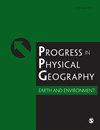长叶树-年轮网络:回顾与拓展古松的应用。Dendrochronological数据
IF 3.6
3区 地球科学
Q2 GEOGRAPHY, PHYSICAL
Progress in Physical Geography-Earth and Environment
Pub Date : 2023-01-02
DOI:10.1177/03091333221147652
引用次数: 1
摘要
长叶松(Pinus palustris Mill.)及其相关生态系统是美国东南部(US)的标志。从德克萨斯州到佛罗里达州再到弗吉尼亚州,曾经覆盖了大约3700万公顷的土地,在过去的大约100年里,这种物种的濒临灭绝和随后的恢复努力已经得到了充分的记录。尽管长叶松是美国东南部最长寿的树种之一——有记载的年龄超过400年——但在树木年代学领域,长叶松的用途尚未得到审查。本文综述了长叶松年轮数据在气候学和古气候重建、火灾史、生态学和考古/文化研究四个主要研究领域的应用。此外,我们强调了这些主题领域的知识差距,为此我们引入了长叶树环网络(LTRN)。LTRN的首要目的是联合合作伙伴和数据,以扩大美国东南部长叶松年轮数据的科学应用。作为LTRN分析的第一个例子,我们表明,季节性木材年表(早木宽度、晚木宽度和总宽度)的发展增强了长叶松年轮数据的实用性,表明这些季节性木材指标对未来研究的价值。研究发现,在21个样点上,晚木宽度年代学的平均相关系数均优于早木和全木宽度年代学(RBAR分别为0.55、0.46和0.52)。在美国东南部增加长叶松树木年代学效用的战略计划包括[1]从腐烂、提取和火灾消耗中保存残余材料(如树桩、原木和建筑建筑木材),以帮助扩展树木年轮记录,[2]在LTRN空间间隙中开发新的年代学,以促进在主题组所提出的背景下对长叶松生态系统的大范围分析。本文章由计算机程序翻译,如有差异,请以英文原文为准。
The Longleaf Tree-Ring Network: Reviewing and expanding the utility of Pinus palustris Mill. Dendrochronological data
The longleaf pine (Pinus palustris Mill.) and related ecosystem is an icon of the southeastern United States (US). Once covering an estimated 37 million ha from Texas to Florida to Virginia, the near-extirpation of, and subsequent restoration efforts for, the species has been well-documented over the past ca. 100 years. Although longleaf pine is one of the longest-lived tree species in the southeastern US—with documented ages of over 400 years—its use has not been reviewed in the field of dendrochronology. In this paper, we review the utility of longleaf pine tree-ring data within the applications of four primary, topical research areas: climatology and paleoclimate reconstruction, fire history, ecology, and archeology/cultural studies. Further, we highlight knowledge gaps in these topical areas, for which we introduce the Longleaf Tree-Ring Network (LTRN). The overarching purpose of the LTRN is to coalesce partners and data to expand the scientific use of longleaf pine tree-ring data across the southeastern US. As a first example of LTRN analytics, we show that the development of seasonwood chronologies (earlywood width, latewood width, and total width) enhances the utility of longleaf pine tree-ring data, indicating the value of these seasonwood metrics for future studies. We find that at 21 sites distributed across the species’ range, latewood width chronologies outperform both their earlywood and total width counterparts in mean correlation coefficient (RBAR = 0.55, 0.46, 0.52, respectively). Strategic plans for increasing the utility of longleaf pine dendrochronology in the southeastern US include [1] saving remnant material (e.g., stumps, logs, and building construction timbers) from decay, extraction, and fire consumption to help extend tree-ring records, and [2] developing new chronologies in LTRN spatial gaps to facilitate broad-scale analyses of longleaf pine ecosystems within the context of the topical groups presented.
求助全文
通过发布文献求助,成功后即可免费获取论文全文。
去求助
来源期刊
CiteScore
7.20
自引率
5.10%
发文量
53
审稿时长
>12 weeks
期刊介绍:
Progress in Physical Geography is a peer-reviewed, international journal, encompassing an interdisciplinary approach incorporating the latest developments and debates within Physical Geography and interrelated fields across the Earth, Biological and Ecological System Sciences.

 求助内容:
求助内容: 应助结果提醒方式:
应助结果提醒方式:


